1940
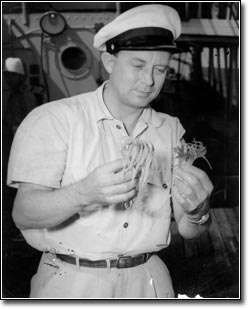
Dr. Bowman F. Ashe, president of the University of Miami from its beginnings fourteen years before, and Dr. F.G. Walton Smith, a thirty-one year old British marine scientist who was working on sponge fishery problems for the Colonial Office in the Bahamas Islands, met by chance in the quadrangle of the Anastasia Building on the University’s old North Campus in central Coral Gables. They discovered a mutual interest in developing an institution for tropical marine research in Miami. At President Ashe’s invitation, Dr. Smith came to the University in the fall of 1940 to be an assistant professor in the Department of Zoology and begin organizing a marine laboratory, although at the time the University could provide neither the necessary physical plant nor financial support for it.
(Right) F.G. Walton Smith, circa 1940
When Walton Smith and his charming wife, May, moved to Miami from Nassau, they felt at home. They had already met and liked many of the South Florida sport fishermen and yachtsmen who regularly visited the Bahamas Islands and, from this circle of friends, they were able to draw support as Dr. Smith’s vision took shape. Miami was a small city then, with a population of less than 250,000. Its location was ideal for a tropical marine laboratory.
1943
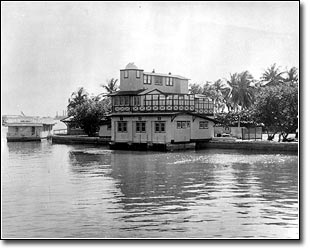 The University Board of Trustees formally established the UM Marine Laboratory on February 1, 1943, with a resolution that read in part: "it is further proposed that leaders in the field of oceanographic research, as well as institutions devoted thereto, be invited to associate themselves with this laboratory." Dr. Smith found a temporary waterfront site for the "Marine Lab" as it came to be known, in a boathouse on the estate of the late Joseph H. Adams on Belle Isle in Miami Beach.
The University Board of Trustees formally established the UM Marine Laboratory on February 1, 1943, with a resolution that read in part: "it is further proposed that leaders in the field of oceanographic research, as well as institutions devoted thereto, be invited to associate themselves with this laboratory." Dr. Smith found a temporary waterfront site for the "Marine Lab" as it came to be known, in a boathouse on the estate of the late Joseph H. Adams on Belle Isle in Miami Beach.
(Left) The boathouse on Miami Beach.
1944
The two staff members, Dr. Smith, director, and Dr. Robert H. Williams of the Botany Department, assistant director, and their students devoted themselves to wartime teaching and research. Dr. Smith was able to acquire the first funding, a subcontract from the Woods Hole Oceanographic Institution for a study of marine fouling for the Navy’s Bureau of Ships. Also, at a small testing station they built in the mangroves of Matheson Hammock, they observed the effects of tropical marine conditions on construction materials, paints, and cordage.
1945
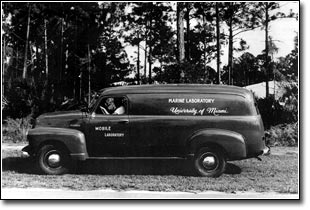
When the piling collapsed under the boathouse and it could no longer be used, the growing staff moved into converted apartment building on Santander Avenue in Coral Gables. There they had seawater for the aquariums brought in by tank truck.
Dr. Smith asked three directors of established scientific centers and one chief of a government agency to act as an advisory committee. Their counsel was invaluable in the Lab’s formative stages. In a report prepared for President Ashe and the Board of Trustees, they recommended that the Marine Laboratory’s program should maintain the three-fold objectives of teaching, basic research, and applied marine research.
The State of Florida Board of Conservation engaged the UMML for a survey of Florida fisheries. The researchers equipped a panel truck and three station wagons with scientific gear and called them mobile laboratories (right). They traveled to small field stations set up around the state and chartered boats as needed for sampling.
As World War II was coming to an end, Dade County was preparing to resume construction of a toll causeway to Virginia Key and Key Biscayne. Charles Crandon, a member of the County Commission, Walton Smith, and a committee of UM trustees proposed that an aquarium be built on Virginia Key as part of parkland development. The Marine Laboratory would operate it in exchange for land for a waterfront campus and a percentage of the admissions charge. Dr. Smith and the university architect, Marion Manley, put much time and thought into an elegant design for the installation. Thomas Barbour, David Fairchild, and Gilbert Grosvenor joined Walton Smith on a boat trip to Bear Cut to choose the site.
1946
Dr. Smith described his view of the future in an article for Science, "Function and Development of a Tropical Marine Laboratory." In it, he set the course for the Lab ’ s growth from a biological laboratory to an oceanographic institution that he followed as director and eventually as dean of the Rosenstiel School of Marine and Atmospheric Science.
In November, when patches of discolored water appeared off the coast of southwest Florida and huge quantities of dead and dying fish washed ashore on the beaches, Mr. J.N. “Ding” Darling, a winter resident of Captiva Island and a well-known amateur naturalist, called the University of Miami and with his own funds helped defray the expenses of biologists who set out to investigate the red tide problem in January 1947. Dr. Smith and Dr. Williams and their students answered the call. After extensive collecting, water sampling, and analysis, Charles C. Davis of the marine Lab group wrote a careful description and named a new species of the dinoflagellate causing the problem, Gymnodinium brevis. The rapid reproduction, or "bloom" of the single celled organism formed concentrations of 60 million to the quart which were poisonous to fish. With support from the U.S. Fish & Wildlife Service, the work on red tides continued for several years at the Marine Lab and elsewhere to try to determine the conditions that could produce the massive blooms that discolored the waters and discouraged the tourists. Oceanographers Ilmo Hela and Frank Chew carried out an exacting study of water currents and tides, and found a relationship to the amount of brackish water entering the ocean and so to the amount of freshwater entering the bays from river drainage.
1947
The Florida legislature, prodded by the Dade delegation, appropriated money to support the Marine Laboratory as an agency of the State Board of Conservation, which had no research facility and little budget of its own. The Lab did research on commercial fisheries and sport fisheries and reported its findings in a well-written educational and technical bulletins for more than 12 years until a state marine laboratory opened in St. Petersburg. The first publication in 1948 summarized what had been learned about Florida red tide. It was revised in 1952 by Robert Ingle and Donald P. de Sylva as research continued.
1948
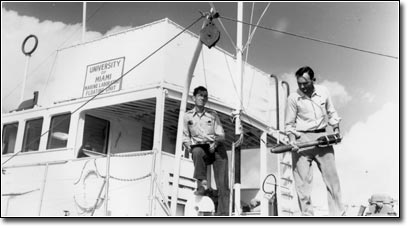
Dr. C.P. Idyll, a fishery biologist, came from the International Pacific Salmon Fishery Commission to be a research associate at the UMML for the Board of Conservation.
By now, Dr. Smith and his colleagues were consulting on fisheries problems all over the Caribbean region. With encouragement from Dr. Richard Kahn of the U.S. Fish and Wildlife Service, Smith organized the Gulf and Caribbean Fisheries Institute to bring together scientists, commercial fishermen to exchange information and ideas at the Marine Laboratory would publish and distribute the proceedings. Dr. Smith was chairman of the GCFI until 1959 when Clare Idyll took over as chairman and executive secretary. Jim Higman became executive secretary in 1960, arranging the well-attended meetings and editing the Proceedings until 1984.
From war surplus made available to scientific institutions by the federal government, the Marine Laboratory acquired a Navy AVR craft, 104 feet long but without an engine, to moor at Miami Beach for water access. Charles P. Johnson, a big game angler, provided funds to modify the vessel, named PHYSALIA, (left) to be a research platform with a circulating seawater system. The Johnson foundation also helped acquire another PHYSALIA at a later date. A former Coast Guard cutter, she was used in red tide research.
The University College of Liberal Arts authorized a new Department in connection with the UMML, the Department of Marine Science. Curricula in fisheries, marine biology, and oceanography that had been offered in various departments by faculty members who worked as research associates at the Marine Lab now could be consolidated in the new department. Courses leading to a master’s degree were offered. Dr. Williams was chairman. The first Master of Science degrees in marine biological science were awarded to Herman Doochin and Robert Woodmanese in June 1949.
1949

Tagging studies on sailfish carried out in cooperation with the West Palm Beach Sailfish Conservation Club and other groups attracted the attention and allegiance of the wealthy men who fished for tuna, marlin, and sailfish. Some, like Lou Marron and Alfred Glassell, holder of the world record for black marlin, organized field research aboard their boats. Others donated boats for student use or to be sold for funds for research. One, John K. Howard, financed a program on the worldwide abundance and distribution of marlin and collected data for it himself. Robert E. Maytag endowed a chair in ichthyology and graduate fellowships. These people and their friends played an important part in the early development of the Marine Laboratory.
With increasing amounts of subsidized research, it was possible to recruit biologists, chemists and other specialists to create a well-coordinated research team. Two small boats suitable for inshore work, the 39-foot MEGALOPA and the 27-foot NAUPLIUS, (right), had been donated to the University. Still, despite all the director’s efforts, the laboratory lacked an oceanside facility and a ship for serious offshore work.
Dr. Charles Lane and Dr. Hilary Moore joined the teaching and research faculty. Dr. Lane took over work on marine borers and directed intensive studies of their physiology. Dr. Moore became assistant director. About this time, Gilbert Voss was a teaching fellow. He was made curator of the invertebrate collection. Both graduate and undergraduate students were collecting buckets of specimens while on field trips to study the rich fauna of Biscayne Bay and the reefs.
The expanding staff moved again, this time to larger quarters in the building that had housed the UM Law School at 439 Anastasia Avenue, (below) across the street from the Anastasia classroom building.
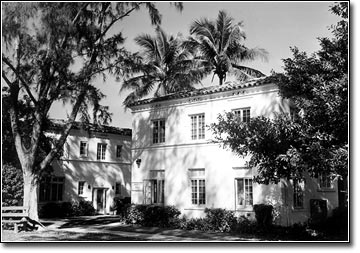
The faculty and research assistance of the Marine Lab had developed a feeling of camaraderie and community. Walton Smith hung a bell on the balcony of the new building. At the close of each working day, he would ring the bell and all would troop to either Henri’s, a pub nearby on Ponce, or Black Mike’s on Bird Road to discuss the day’s activities. Dr. Smith developed his management style during these years. He believed administration should provide some structure, but should not get in the way of research.
1950
The National Science Foundation came into existence. The Office of Naval Research had been set up in 1946 with its primary purpose support of research of direct use to the Navy, but also wide-ranging unclassified basic research. Both were charged with funding university research. The Foundation decided to evaluate research proposals through various forms of peer review. Highly skilled scientists and engineers formed the basic personnel element of the agency. The ONR had organized itself with a similar paradigm. Both of these federal agencies, and others that were created about this time, adopted a flexible grant mechanism that involved reimbursement to a university for the direct and indirect costs of funded research.
As student enrollment grew rapidly in the post-war years, the full attention of University administrators and trustees turned to building the main campus, postponed during the Depression and World War II. Dr. Ashe told Dr. Smith that he would have to find funding for facilities for the Marine Lab himself. President Ashe died late in 1952. He lived to see the rededication of the Merrick Building, but Dr. Jay F. W. Pearson, who had been vice-president, led the development of the University through the fifties. He had taught the first courses in marine biology when the UM was founded and continued its commitment to marine studies.
The National Geographic Society cooperated in a joint study of oceanic plankton directed by Dr. Smith and Dr. Moore. Work was conducted on a year-round basis in the Florida Current between South Florida and the Bahamas. Harding Owre Michel, who recently had completed a master’s degree at the University of Miami, worked on the project at sea and in the laboratory. Gilbert Voss looked at the larval cephalopods that were abundant in the plankton collected. Results were reported in the magazine and in the Society’s technical reports.
Florida commercial shrimpers discovered new shrimp beds in water 16 to 20 fathoms deep north of Dry Tortugas. The beds contained huge pink shrimp of the species Penaeus duodarum. State and industry sponsored work began under the direction of Dr. Idyll on both the commercial aspects of the fishery and the life cycle of the species. During the fifties and sixties, the ecology of this valuable species became a multidisciplinary investigation with funding from several sources, including the U.S. Fish and Wildlife Service.
1951
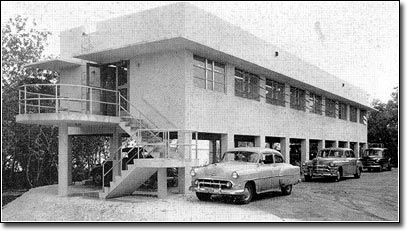
Although Dr. Smith’s hoped-for aquarium project was stalled by the failure of a municipal bond issue to pass, Dade County offered to lease 6.38 acres of land on Bear Cut to the University provided construction of the first building for the Marine laboratory could begin within a year. Director Smith turned to the fishing and boating community and raised all but a few thousand dollars of the money needed as the deadline approached. Then the evening newspaper, The Miami News, ran an editorial, "Give a Buck to the Marine Lab," and more donors came to the rescue. As a result, the long-term lease was secured and $50,000 was available to erect and equip the first unit. It was named for Louis Agassiz, the naturalist who studied the Florida reefs and reported his findings to the U.S. Senate in 1851-52. The Agassiz Building, (above) designed by Marion Manley, had no interior walls pipes and conduits were exposed for easy rearrangement to serve changing functions. Seawater for the aquariums could be pumped directly from Bear Cut, so PHYSALIA was retired. Harding Owre Michel was the first staff member to move to Virginia Key when the building was completed in 1953.
Good fortune smiled again when the U.S. Army assigned a 65-foot motor vessel, the T-19, to the Marine Lab. Harry Tucker was the engineer, and later, skipper.
Robert Ginsburg, who was working toward his doctorate at the University of Chicago, answered an advertisement for a research assistant in marine geology at the University of Miami. He was hired by Walton Smith and soon found himself conducting research on carbonate sediments under a contract with the American Petroleum Institute. A proposal Ginsburg wrote to the National Science Foundation brought him and the Marine Lab the Foundation’s first grant in earth science.
Perceiving a need for a scientific journal dedicated to publishing papers of primarily biological interest dealing with the tropical and subtropical waters, Dr. Smith and his colleagues founded one: the Bulletin of Marine Science of the Gulf and Caribbean. Dr. Hilary Moore was editor, Walton Smith, managing editor. In 1965, the name was shortened to Bulletin of Marine Science, and the scope was broadened to cover papers in the geological, chemical, and physical sciences pertinent to marine biology. a separate section in each issue would be devoted to papers on coral reefs. Today, the Bulletin is considered an internationally leading journal devoted to the dissemination of high-quality research from the world's oceans. Dr. Joseph E. Serafy is the editor.
1952
F.G. Walton Smith began a one-man campaign to raise funds to develop the Virginia Key campus and to increase the scientific staff. He organized the Marine Laboratory Association. One of its members, George Collier, made a gift of property and securities to construct a second laboratory building similar in features to the first. It was named for Alexandrine duPont Collier. In 1953, the Association was chartered as the International Oceanographic Foundation with its first goal the underwriting of the long-delayed aquarium. However, Dade County signed a contract with the Marine Exposition Corporation instead. The Seaquarium opened to the public two years later. The officers of the I.O.F. were Charles F. Johnson, president, Walton Smith, vice-president, and John Mahony, treasurer. Mrs. F. May Smith helped publish the Foundation’s quarterly bulletin, Sea Frontiers, doing the layouts on her dining room table. she later was managing editor with E. John Long, formerly of the National Geographic Magazine, as associate editor. By 1968, the International Oceanographic Foundation had a membership of 70,000 readers of Sea Frontiers.
1953
Dr. H. Horton Sheldon of the UM School of Engineering and retired Admiral William L. Freseman obtained and set up a high-powered ST-1M radar transmitter system in the tower of the Merrick Building. The Radar Research Laboratory was integrated with the Marine Laboratory. Meteorologists Home Hiser, G.F. Andrews, and H.V. Senn tracked tropical storms by radar, researching hurricane structure and internal motions. They taught courses on theory and application of weather radars to National Weather Service personnel from all over the country.
By its tenth anniversary, the UMML had progressed to the point where it had an income from grants and contracts amounting to $284,107, and a staff of scientists and other personnel numbering over sixty. Thirty-five were research assistants, among them Nancy Voss, Joseph Richard, Harding Michel, Sigmund Miller, Samuel Meyers. Kou Walter and Harry Tucker were boat masters. Robert Thornhill was shop foreman and John F. Zipf had come aboard as administrative assistant and to manage research accounts.
1954
Red tide struck again, fouling the beaches on the west coast of Florida. PHYSALIA II and T-19 went to the Gulf to track it. Twenty-one hundred numbered red cards coated in plastic were released and a record kept of the latitude and longitude of each drop. In the course of this project, a large eddy was discovered in the Gulf of Mexico. Over one third of the cards were recovered. Some still were being returned years later.
1955
The Collier Building was ready for occupancy, and a pier was under construction. Brigadier General Robert Wood Johnson donated to the I.O.F. for the Marine Laboratory his private yacht, the 78-foot GERDA, which had a sturdy North Sea trawler hull. When fitted out with oceanographic gear, GERDA, a fine, seagoing vessel, served long and well as an offshore research vessel. Kou Walter was captain.
1956

With added numbers of scientific and support personnel, the administration of the Marine Laboratory was becoming unwieldy and its Coral Gables facilities cramped. Groups formed according to discipline: oceanography and meteorology fisheries science, marine biology; acoustics, electronics, and instrument design. a large department library provided standard oceanographic references and the principal scientific marine journals of the world. A museum collection of marine fishes and invertebrates was continually being enlarged.
Ground was broken for the main building on the Virginia Key campus and when the first two-story wing was completed in 1957, (right) all personnel and the library moved from Coral Gables. In 1959, a third story and the east wing were added and there was space for the collections. With funds from the National Science Foundation, the north wing was constructed in 1965. In 1967, the building was named for Gilbert Hovey Grosvenor, president of the National Geographic Society from 1920 to 1954. a winter resident of Coconut Grove, he had visited frequently at the Marine Lab.
1957
The International Geophysical Year, a worldwide scientific undertaking, opened July 1, 1957 and extended through December 31, 1958. The U.S.S.R. was one of the fifty-six nations participating. In October, the Russians shocked the world when they launched the first man-made earth satellite, Sputnik. They surprised the U.S. oceanographic community as well when one of their fleet of modern well-equipped oceanographic research vessels taking part in the IGY, the 363-foot VITAYZ made a port call in San Francisco. In response to the Soviet accomplishments and the climate of cold-war competition, America shifted its space program into high gear and began to expand funding for science at a rapid pace. In 1958, appropriation for the National Science Foundation was $40 million, the next year it was $134 million. By 1968, the NSF Graduate Science Facilities Program was providing matching grants to help universities build new facilities.
The National Academy of Sciences outlined the need for a national oceanographic research effort in the first of a series of reports that appeared in 1959, "Oceanography 1960 to 1970." The Academy’s committee on oceanography recommended that for economic and military survival, the United States should inaugurate a long-range oceanographic agenda. In 1961, the U.S. Navy laid out an ambitious $900 million, ten year program, TENOC-61. With the new onshore facilities, sturdy, small, but fully equipped research vessel and the well-earned reputation of its director and faculty for good science, the UM Marine Laboratory was in position to play a role in the burst of rederally-sponsored oceanographic research.
In January, 1957, Cesare Emiliani came to the University of Miami from the University of Chicago. Dr. Emiliani worked on Foraminifera, microscopic skilled organisms quite abundant in the fossil record. Dr. Emiliani was interested in great climate changes known to have occurred during the Pleistocene Age and he was sure these tiny shells depositedin the ubiquitous ooze that coats the sea bottom held important clues. He was looking for a place to work where there were ships and trained personnel to help him to obtain core samples of the deep-sea sediments. Paleontological and oxygen isotopic analysis of the changing foraminiferal faunas in the cores would reveal accurate information on the temperature of the ocean surface waters and their variation through time. An interview with Dr. Smith convinced him to do his work at the Marine Laboratory.
Some time later the same year, Dr. Smith told Cesare Emiliani he wanted to increase the Lab’s expertise in the physical sciences. Dr. Emiliani suggested inviting Dr. Fritz F. Koczy, an Austrian scientist working with Hans Petersson at the Oceanographic Institute in Goteborg, Sweden, to come to Miami. Dr. Koczy had organized and participate in the worldwide cruise of the ALBATROSS in 1947-1948 and had provided Emiliani samples of cores taken by ALBATROSS in the Atlantic. His area of research covered the entire field of oceanography. Dr. Koczy came to the UMML as an associate professor and became chairman of the Division of Physical Science when it was established two years later. Fritz Koczy was largely responsible for the highly successful development of the Division during the 1960s.
With his comprehensive knowledge of what was being done in ocean science and his charisma, he was able to attract outstanding faculty members and to secure large federal grants and contracts.




 The University Board of Trustees formally established the UM Marine Laboratory on February 1, 1943, with a resolution that read in part: "it is further proposed that leaders in the field of oceanographic research, as well as institutions devoted thereto, be invited to associate themselves with this laboratory." Dr. Smith found a temporary waterfront site for the "Marine Lab" as it came to be known, in a boathouse on the estate of the late Joseph H. Adams on Belle Isle in Miami Beach.
The University Board of Trustees formally established the UM Marine Laboratory on February 1, 1943, with a resolution that read in part: "it is further proposed that leaders in the field of oceanographic research, as well as institutions devoted thereto, be invited to associate themselves with this laboratory." Dr. Smith found a temporary waterfront site for the "Marine Lab" as it came to be known, in a boathouse on the estate of the late Joseph H. Adams on Belle Isle in Miami Beach.





